Create your own boot logo
http://www.arm9board.net/wiki/index.php?title=Create_your_own_boot_logo Create your own boot logo In this tutorial there will be explained how to show your own image on the LCD display while your Linux system is booting. Contents [hide] 1 Preparations 2 Developping the boot logo 2.1 Converting the image 2.2 Going to a 224 color image 3 Put it inside the Kernel image 3.1 Editing the necessary files 3.1.1 Edit the Makefile 3.1.2 Edit the logo.c file 3.1.3 Edit the Kconfig file 3.2 Editing the header file 3.2.1 For the 2.6.28 kernel version 3.2.2 For the 2.6.36 kernel version
